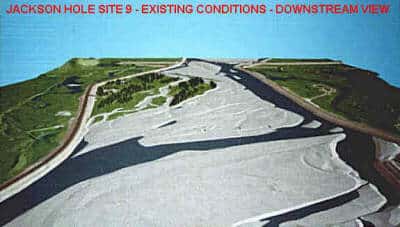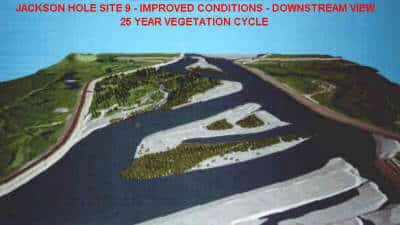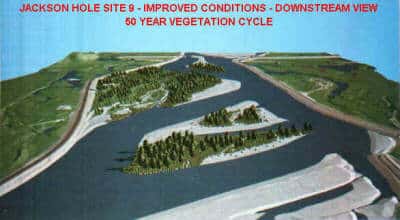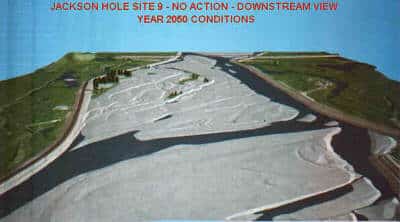Also known as the Jackson Hole Environmental Restoration and Snake River Levee Mitigation Project
“It was the best of times, it was the worst of times. It was a step in the right direction, it was a leap in the wrong direction.”
-excerpt from A Tale of Two Districts
It may be the best thing to happen to the Snake River since the piecemeal construction of the Army Corps of Engineers levee system began in the 1950s, or it may turn out to be a complete failure. Sometimes referred to as the Snake River Restoration Project, its goal is to mitigate and hopefully reverse the deleterious effects of the aforementioned levee system on fish and wildlife habitat on the South Fork of the Snake River as it flows through Jackson Hole. Can it succeed, or is it doomed before it even gets started?
It is ironic that even as the Cheyenne District of the Army Corps of Engineers continues adding to the levee system as recently as the spring of 1997, the Corps is now, and has for the last two years, been conducting a study (the Walla Walla District, that is) to evaluate the feasibility of mitigating the destruction caused by the levees. Its ironic because as recently as last spring as the Corps prepared to construct more levees, Chandler Peter, project manager for the Cheyenne District of the Army Corps of Engineers would not even admit to this columnist that the levees have had any detrimental effects on the Snake. “There is no hydrological evidence to support that conclusion,” was his response to my query regarding the cumulative and detrimental effects of the levees on fish and wildlife habitat in and around the Snake River. Talk about the left hand not knowing what the right hand is doing. But it gets worse, more on that later.
The Snake River Restoration Project is a collaborative effort between Teton County, the U.S. Army Corps of Engineers (Walla Walla District) and the Teton County Natural Resource District (TCNRD) along with a host of federal and state agencies, local organizations and private citizens. The Corps and TCNRD are halfway through a four year study which is designed to determine the feasibility of repairing the multifaceted damage caused by the levees over the years. While total restoration is not possible, some of the goals of the project include improving biodiversity, restoring fisheries by increasing and improving spawning areas for the Snake River Cutthroat trout, protecting and/or rebuilding forested mid-river islands, and allowing some water to flow behind the levees to restore creeks and riparian habitat.
This Could Get Ugly
Essentially, this is the situation. Levees wreak their havoc in a variety of ways, not the least of which includes increasing the velocity of water flows. Since the Snake River levees hem in a river which historically wants to spread out over its flood plain, the same amount of energy (assuming equal flow volume) is funneled through a narrower pipe, so to speak. This, quite naturally, increases the rate of the flowing water which in turn increases the erosion of mid-river islands as well as the flushing of fish habitat in the form of log jams and so on. Levees also cut off access to the spring creeks used by the Snake River Fine-Spotted Cutthroat for spawning. The levee system has trashed the river and surrounding riparian habitat so severely that if nothing is done the 22 miles of Snake River between Grand Teton National Park and South Park will ultimately become a barren watercourse virtually devoid of vegetation, and perhaps wildlife as well. This, according to Corps (Walla Walla District) projections for the next 50 years (see graphics).




But oh, I forgot, “there is no hydrological evidence to support that conclusion.” Yeah, right.
While the Snake River Restoration Project is an attempt to avoid such a scenario, what if the worst came to pass? I wonder how many wealthy second home owners will want to reside by that Snake River! I wonder if their property values will plummet. I wonder if tourists will still flock to Jackson Hole to revel in its beauty. I wonder if we are trading the long term ecological and economic (yes, economic) benefits of a healthy river system for the benefit of a select few. While the ultimate solution to the levee problem is their outright removal, another acceptable solution would be to move the levees to the fringe of the historical, say, 200 year flood plain. Watch nature bounce back should that ever happen. But since that is perhaps too much to hope for, the Snake River Restoration Project is perhaps our best hope for the future.

Rebuilding a River
So just how do you reverse levee damage? The truth is, in a high-energy river system such as the Snake, no one really knows for sure. Whether it can be done at all is very much in doubt. The Corps proposals have been garnered from similar projects on lower-energy river systems with modifications, of course, which will hopefully offset the significantly higher-energy hydraulics of the Snake.
Specifically, the experimental mitigation measures include:
- Selective gravel removal to stabilize and create channels.
- Physically anchoring “woody debris,” such as logs, to the river bed with steel cables in the hope of slowing water and catching floating debris such as other logs.
- Constructing brush fences on islands which are also designed to slow water and catch floating debris, hopefully allowing islands to rebuild themselves as rock and silt are deposited in the slower water.
- Building “spur dikes” along the levees which will deflect and slow flows as well as catching debris in an effort to create fish habitat.
Of course, such measures will not be implemented all at once on a river-wide basis. The project is scheduled to be completed in stages, the first stage of which could begin as soon as March 98 just upstream from the Wilson Bridge. The Demonstration Project’s primary purpose is to test the various restoration techniques in the high-energy Snake River environment and determine how effective those experimental techniques are and what, if any, are the cumulative effects of said techniques. However, a permit will need to be issued by the Cheyenne District of the Army Corps of Engineers before construction can proceed.
In two years, when the Demonstration Project is evaluated and the broader study completed, implementation of the mitigation measures can begin at the three (one at a time) other sites which are currently part of the study. If successful, the mitigation measures could then be applied to other sections of the river. Needless to say, all of this will take years. And there is no guarantee the entire river, or even the other study sites, will ever derive the benefits of the study.
It should also be noted that when structures such as brush fences and spur dikes are first constructed, they aren’t going to be pretty. Their appearance will be unnatural and some people are going to howl louder than a reintroduced Yellowstone wolf. Hopefully, public education regarding the purpose and goals behind such structures will result in the support which will be as necessary to the projects success as will be funding.
Meanwhile, Back at the Ranch
Now, back to that permit required for the Demonstration Project to begin. It was denied by the Cheyenne District of the Corps (remember our friend Chandler Peter?). A year ago, when wealthy landowners who have built multimillion-dollar homes in the Snake’s ten year flood plain needed permits to build levees, the Corps fell all over itself to expedite that process. The position of the Corps was clear. Lets cut through this bureaucratic red tape and get some levees built before runoff carries these homes to the Palisades Reservoir.
But will the Cheyenne District show the Walla Walla District and the TCNRD the same courtesy when it comes to the Snake River Restoration Project? Apparently not. The TCNRD was told by Cheyenne to reapply for a permit, but this time instead of a Nationwide permit they were told to apply for an Individual permit. To make a very long story very short, Nationwide permits can be granted virtually overnight, while Individual permits require months of hoop jumping. Furthermore, there is no guarantee the Individual permit will ever be granted or that the Cheyenne District will ever grant any permit needed for the Restoration Project to begin construction. And that makes me very nervous, especially when the Cheyenne District denies the existence of “hydrological evidence” which the Walla Walla District has been collecting for years. Welcome to the wonderful world of federal bureaucracies. Its a tale of two districts.
Guy Turck
Jackson Hole
March 1998
